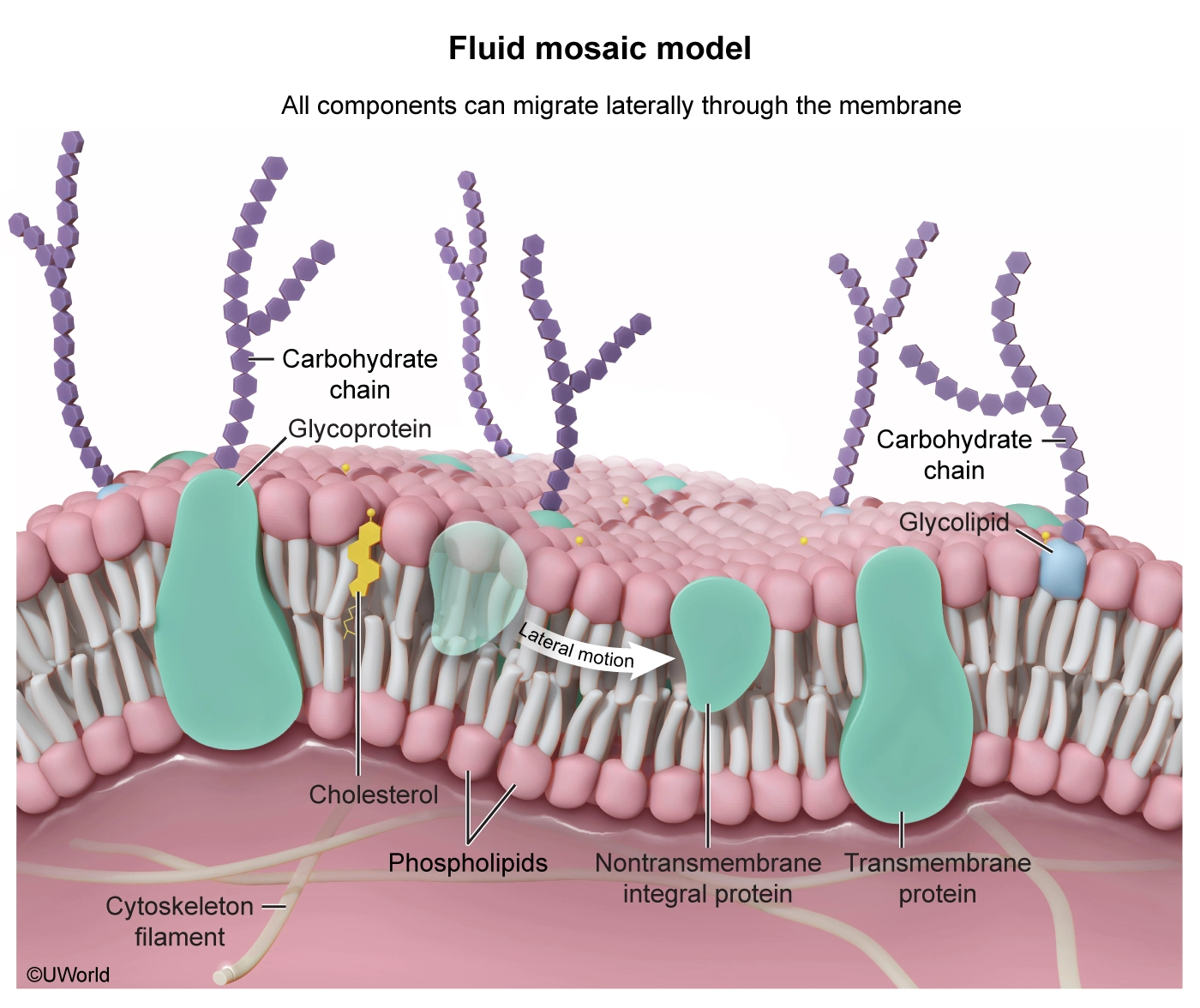The MCAT (Medical College Admission Test®) is a critical component of your journey toward medical school. It tests knowledge across four distinct sections, each focusing on key areas of science and critical thinking applicable in medicine. We’ll dive deeper into the topical composition of each MCAT section, at what level you need to know these subjects, and how MCAT topics are tested.
MCAT Sections
There are four MCAT sections that students should be aware of as they prepare for the exam. These sections assess a variety of MCAT topics, from biology and chemistry to psychology, with the first three focusing on science knowledge and the fourth on critical thinking and reading comprehension.
- Biological and Biochemical Foundations of Living Systems
- Chemical and Physical Foundations of Biological Systems
- Psychological, Social, and Biological Foundations of Behavior
- Critical Analysis and Reasoning Skills (CARS)
The first three MCAT sections are organized around foundational concepts in the sciences. They require a deep knowledge of important scientific concepts rather than disconnected scientific facts. Examinees are expected to be able to integrate and analyze information from different disciplines to reach scientific conclusions.
The fourth MCAT section, CARS, contains passages and questions that examine your ability to comprehend and analyze what you read (similar to a verbal-reasoning test). The CARS section of the exam covers a wide range of disciplines in the social sciences and humanities, and measures the analytical and reasoning skills needed to be successful in medical school.
MCAT Sections Detailed Breakdown
The topics covered vary by MCAT section, and are examined according to a well-defined structure provided by the AAMC®. Below you will find the question count, allotted time, disciplines, examined skills, and foundational concepts for each MCAT section.
Biological and Biochemical Foundations of Living Systems
This section of the MCAT focuses on the essential parts of the MCAT related to biology and biochemistry.
|
Number of Questions & Allocated Time |
59 Multiple-Choice Questions (passage-based and discrete) 95 Minutes |
||
|
Disciplines |
Introductory biology - 65% First-semester biochemistry - 25% General chemistry - 5% Organic chemistry - 5% |
||
|
Scientific Inquiry & Reasoning Skills |
Skill 1 - 35% Skill 2 - 45% Skill 3 - 10% Skill 4 - 10% |
||
|
Foundational Concepts |
Foundational Concept 1 - 55% Foundational Concept 2 - 20% Foundational Concept 3 - 25% |
The Biological and Biochemical Foundations of Living Systems section tests processes unique to living organisms, such as maintaining a constant internal environment, growing and reproducing, acquiring materials and energy, sensing and responding to environmental changes, and adapting. It also examines your knowledge of how cells and organ systems within an organism act to accomplish these processes. You must be able to reason about these processes at various levels of biological organization within a living system.
Topics You Need to Know
- Introductory-level biology, organic chemistry, and inorganic chemistry
- Biochemistry (usually taught in the first semester)
- Cellular and molecular biology (usually taught in introductory-level biology sequences and first-semester biochemistry courses)
- Basic research methods and statistics
- Scientific inquiry and reasoning, research methods, and statistics skills as applied to the natural sciences
Chemical and Physical Foundations of Biological Systems
In this section, you'll face questions about the fundamental principles of chemistry and physics within biological contexts.
|
Number of Questions & Allocated Time |
59 Multiple-Choice Questions (passage-based and discrete) 95 Minutes |
||
|
Disciplines |
General chemistry - 30% First-semester biochemistry - 25% Introductory physics - 25% Organic chemistry - 15% |
||
|
Scientific Inquiry & Reasoning Skills |
Skill 1 - 35% Skill 2 - 45% Skill 3 - 10% Skill 4 - 10% |
||
|
Foundational Concepts |
Foundational Concept 4 - 40% Foundational Concept 5 - 60% |
The Chemical and Physical Foundations of Biological Systems section tests the mechanical, physical, and biochemical functions of human tissues, organs, and organ systems. You will need to understand the basic chemical and physical principles that underlie the mechanisms operating in the human body, and apply this understanding to living systems.
Topics You Need to Know
- Introductory-level biology, organic chemistry, inorganic chemistry, and physics
- Biochemistry (usually taught in the first semester)
- Molecular biology (usually taught in introductory-level biology sequences and first-semester biochemistry courses)
- Basic research methods and statistics
- Scientific inquiry and reasoning, research methods, and statistics skills as applied to the natural sciences
Psychological, Social, and Biological Foundations of Behavior
This section examines how psychological and sociological concepts relate to human behavior.
|
Number of Questions & Allocated Time |
59 Multiple-Choice Questions (passage-based and discrete) 95 Minutes |
||
|
Disciplines |
Introductory psychology - 65% Introductory sociology - 30% Introductory biology - 5% |
||
|
Scientific Inquiry & Reasoning Skills |
Skill 1 - 35% Skill 2 - 45% Skill 3 - 10% Skill 4 - 10% |
||
|
Foundational Concepts |
Foundational Concept 6 - 25% Foundational Concept 7 - 35% Foundational Concept 8 - 20% Foundational Concept 9 - 15% Foundational Concept 10 - 5% |
The Psychological, Social, and Biological Foundations of Behavior section tests your understanding of the ways psychological, social, and biological factors affect perceptions and reactions to the world; what people think about themselves and others; behavior and behavior change; the cultural and social differences that influence well-being; and the relationships between social stratification, access to resources, and well-being.
This section emphasizes the impact of behavior on health, and the concepts that doctors must know when serving a diverse population. It asserts the need for future physicians to manage medicine's human and social aspects.
Topics You Need to Know
- Psychology, sociology, and biology related to behavioral and sociocultural determinants of health, as well as mental processes and behavior
- Basic research methods and statistics
- Scientific inquiry and reasoning, research methods, and statistics skills as applied to the social and behavioral sciences
Critical Analysis and Reasoning Skills (CARS)
The Critical Analysis and Reasoning Skills (CARS) section evaluates your ability to understand, analyze, and evaluate complex passages.
|
Number of Questions & Allocated Time |
53 Multiple-Choice Questions (only passage-based) 90 Minutes |
||
|
Disciplines |
Humanities - 50% Social Sciences - 50% |
||
|
Required Skills |
Foundations of Comprehension - 30% Reasoning within the Text - 30% Reasoning beyond the Text - 40% |
The CARS section is equivalent to a verbal-reasoning test. It examines your ability to understand what you read, and measures the analysis and reasoning skills needed in medical school. You will be required to read passages from a variety of disciplines in the social sciences and humanities, then answer questions that ask you to comprehend, analyze, and reason about the material.
Passage and Question Structure
- Passages are usually between 500-600 words
- Passages are designed to be complex and thought-provoking with sophisticated vocabulary and intricate writing styles
- Information required to answer the questions will be provided (no outside knowledge is needed to do well on the CARS section)
- Passages are typically multifaceted with a focus on the relationships between ideas or theories
- Questions will require you to assess the content while considering the authors’ intentions, tones, and words used to express their points of view
Key Takeaways about CARS
- Tests your comprehension, analysis, and reasoning skills by having you analyze the information in passages
- Includes content from ethics, philosophy, population health, studies of diverse cultures, and a variety of social sciences and humanities disciplines
- All information required to answer the questions can be found in the passages and questions themselves
What Topics Are on the MCAT?
There are 7 MCAT topics, referred to as disciplines, covered across the exam’s four sections. Their content reflects what most colleges teach in introductory-level courses. The topics are:
Scientific Inquiry & Reasoning Skills
The MCAT is designed to examine your ability to combine scientific knowledge with skills in scientific inquiry and reasoning. This must be demonstrated across four such skills that natural, behavioral, and social scientists rely on to advance their work. They are tested in each MCAT section other than CARS, and include the following:
Skill 1 requires examinees to:
- Demonstrate their understanding of scientific concepts and principles
- Identify the relationships between closely related concepts
Skill 2 requires examinees to:
- Reason about scientific principles, theories, and models
- Analyze and evaluate scientific explanations and predictions
Skill 3 requires examinees to:
- Demonstrate an understanding of important components of scientific research
- Reason about ethical issues in research
Skill 4 requires examinees to:
- Interpret patterns in data presented in tables, figures, and graphs
- Reason about data and draw conclusions from it
MCAT Foundational Concepts
The MCAT features 10 foundational concepts that cover “big ideas” in the sciences, and ask students to integrate and analyze information from different disciplines. They apply to each section of the exam other than CARS. Below is an outline of what to expect from the MCAT’s Foundational Concepts:
The first foundational concept examined on the MCAT makes up 55% of the Biological and Biochemical Foundations of Living Systems section. It’s defined by the AAMC as follows:
Biomolecules have unique properties that determine how they contribute to the structure and function of cells and how they participate in the processes necessary to maintain life.
- Structure and function of proteins and their constituent amino acids.
- Transmission of genetic information from the gene to the protein.
- Transmission of heritable information from generation to generation and the processes that increase genetic diversity.
- Principles of bioenergetics and fuel molecule metabolism.
The second foundational concept examined on the MCAT makes up 20% of the Biological and Biochemical Foundations of Living Systems section. It’s defined by the AAMC as follows:
Highly organized assemblies of molecules, cells, and organs interact to carry out the functions of living organisms.
- Assemblies of molecules, cells, and groups of cells within single cellular and multicellular organisms.
- The structure, growth, physiology, and genetics of prokaryotes and viruses.
- Processes of cell division, differentiation, and specialization.
The third foundational concept examined on the MCAT makes up 25% of the Biological and Biochemical Foundations of Living Systems section. It’s defined by the AAMC as follows:
Complex systems of tissues and organs sense the internal and external environments of multicellular organisms, and through integrated functioning, maintain a stable internal environment within an ever-changing external environment.
- Structure and functions of the nervous and endocrine systems and ways these systems coordinate the organ systems.
- Structure and integrative functions of the main organ systems.
The fourth foundational concept examined on the MCAT makes up 40% of the Chemical and Physical Foundations of Biological Systems section. It’s defined by the AAMC as follows:
Complex living organisms transport materials, sense their environment, process signals, and respond to changes using processes understood in terms of physical principles.
- Translational motion, forces, work, energy, and equilibrium in living systems.
- Importance of fluids for the circulation of blood, gas movement, and gas exchange.
- Electrochemistry and electrical circuits and their elements.
- How light and sound interact with matter.
- Atoms, nuclear decay, electronic structure, and atomic chemical behavior.
The fifth foundational concept examined on the MCAT makes up 60% of the Chemical and Physical Foundations of Biological Systems section. It’s defined by the AAMC as follows:
The principles that govern chemical interactions and reactions form the basis for a broader understanding of the molecular dynamics of living systems.
- Unique nature of water and its solutions.
- Nature of molecules and intermolecular interactions.
- Separation and purification methods.
- Structure, function, and reactivity of biologically relevant molecules.
- Principles of chemical thermodynamics and kinetics.
The sixth foundational concept examined on the MCAT makes up 25% of the Psychological, Social, and Biological Foundations of Behavior section. It’s defined by the AAMC as follows:
Biological, psychological, and sociocultural factors influence the ways that individuals perceive, think about, and react to the world.
- Sensing the environment.
- Making sense of the environment.
- Responding to the world.
The seventh foundational concept examined on the MCAT makes up 35% of the Psychological, Social, and Biological Foundations of Behavior section. It’s defined by the AAMC as follows:
Biological, psychological, and sociocultural factors influence behavior and behavior change.
- Individual influences on behavior.
- Social processes that influence human behavior.
- Attitude and behavior change.
The eighth foundational concept examined on the MCAT makes up 20% of the Psychological, Social, and Biological Foundations of Behavior section. It’s defined by the AAMC as follows:
Psychological, sociocultural, and biological factors influence the way we think about ourselves and others, as well as how we interact with others.
- Self-identity.
- Social thinking.
- Social interactions.
The ninth foundational concept examined on the MCAT makes up 15% of the Psychological, Social, and Biological Foundations of Behavior section. It’s defined by the AAMC as follows:
Cultural and social differences influence well-being.
- Understanding social structure.
- Demographic characteristics and processes.
The tenth foundational concept examined on the MCAT makes up 5% of the Psychological, Social, and Biological Foundations of Behavior section. It’s defined by the AAMC as follows:
Social stratification and access to resources influence well-being.
- Social inequality.
What math skills are tested on the MCAT?
Math on the MCAT is constrained to general mathematical concepts and techniques. For example, you will not need to understand calculus, but you will need to understand the following (as provided by the AAMC):
- Recognize and interpret linear, semilog, and log-log scales and calculate slopes from data found in figures, graphs, and tables.
- Demonstrate a general understanding of significant digits and the use of reasonable numerical estimates in performing measurements and calculations.
- Use metric units, including converting units within the metric system and between metric and English units (conversion factors will be provided when needed), and dimensional analysis (using units to balance equations).
- Perform arithmetic calculations involving the following: probability, proportion, ratio, percentage, and square-root estimations.
- Demonstrate a general understanding (Algebra II-level) of exponentials and logarithms (natural and base 10), scientific notation, and solving simultaneous equations.
- Demonstrate a general understanding of the following trigonometric concepts: definitions of basic (sine, cosine, tangent) and inverse (sin‒1 , cos‒1 , tan‒1 ) functions; sin and cos values of 0°, 90°, and 180°; relationships between the lengths of sides of right triangles containing angles of 30°, 45°, and 60°.
- Demonstrate a general understanding of vector addition and subtraction and the right-hand rule (knowledge of dot and cross products is not required).
Frequently Asked Questions
What is the hardest section on the MCAT?
What is the easiest MCAT section?
Do you get a periodic table on the MCAT?
Read More About the MCAT
MCAT Scores, Percentiles, and Pass Rates
Take a deep dive into MCAT scoring to discover what you need to achieve your goals. We cover average scores, breakdowns by section, acceptance rates by score, and more.
MCAT Test Dates & Score Release Dates
View the latest MCAT testing calendar for your country, including registration deadlines and score release dates based on when you take the exam.
Learn about the MCAT registration and scheduling process, including suggested prerequisites, rescheduling information, and various costs and fees.
Learn everything you need to know about the MCAT exam. We’ll walk you through what it is, when to take it, what it covers, its format, and how you should prepare.












